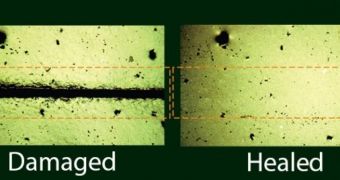It was only recently when a team of researchers working with the University of Standford made it public news that they succeeded in designing and manufacturing a new type of material which would be best described as a self-healing, touch-sensitive synthetic skin.
In other words, this new material is conductive (hence its being referred to as “skin”) and fully capable of regenerating itself infinitely, whenever circumstances demand for it.
According to the scientists who worked on this project, should a piece of this synthetic skin be cut in two, the resulting halves can easily be made to once again bond with one another simply by making them stand next to each other and giving them some time to reconnect.
More often than not, 30 minutes at room temperature are more than enough for this synthetic skin to heal itself, researchers explain.
Extreme Tech argues that this particular feature can really come in handy when designing and manufacturing the electronics of the future.
For example, should this self-healing synthetic skin be used to make the displays of various gadgets, people would no longer freak out over scratching the screen of their gizmos simply because these would be capable of fixing themselves.
As far as touch-sensitivity and conductivity are concerned, researchers explain that these two characteristics of this newly developed synthetic skin can potentially help scientists develop better prosthetic limbs that can actually detect shifts in pressure or temperature, and even let the brain know.
For the time being, the researchers are busy trying to figure out a way of making this touch-sensitive and self-healing synthetic skin transparent.
“Pressure sensitivity and mechanical self-healing are two vital functions of the human skin.”
“A flexible and electrically conducting material that can sense mechanical forces and yet be able to self-heal repeatably can be of use in emerging fields such as soft robotics and biomimetic prostheses, but combining all these properties together remains a challenging task,” their study reads.
Hopefully, news of their progress will soon hit the public eye.

 14 DAY TRIAL //
14 DAY TRIAL //